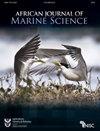在本格拉北部上升流系统中,沙丁鱼sagax和凤尾鱼的低缺氧耐受性可能会限制其种群的恢复
IF 1.4
4区 生物学
Q3 MARINE & FRESHWATER BIOLOGY
引用次数: 0
摘要
本文章由计算机程序翻译,如有差异,请以英文原文为准。
Low hypoxia tolerance in larvae of the sardine Sardinops sagax and anchovy Engraulis encrasicolus may limit their stock recovery in the northern Benguela upwelling system
Physiological traits of five key fish species (Cape hake Merluccius spp., pelagic goby Sufflogobius bibarbatus, Cape horse mackerel Trachurus capensis, European anchovy Engraulis encrasicolus and sardine Sardinops sagax) from the northern Benguela upwelling system (NBUS) were compared during their larval stage by measurements of enzymatic activities of key metabolic enzymes (citrate synthase [CS] and pyruvate kinase [PK]). Two distinct age classes (early larvae: 8‒14 days old; late larvae: 22‒29 days old) for each species and from two areas were compared: Terrace Bay (20° S), the main spawning ground of Cape horse mackerel and anchovy, and Kunene (17° S), near the Angola–Benguela frontal zone, where warm and hypoxic water masses intrude into the NBUS. The results revealed significantly higher CS activity in both larval age classes in Cape horse mackerel, anchovy and sardine compared with Cape hake and pelagic goby. Pelagic goby and Cape horse mackerel had significantly higher PK activity compared with Cape hake, anchovy and sardine, apparent in both larval age classes and both areas. Results for anaerobic metabolism indicate higher capacity for pelagic goby and Cape horse mackerel to recover from oxygen debt built up in prey capture and predator escape behaviour and a higher potential for hypoxia tolerance when compared with Cape hake, anchovy and sardine. These results suggest higher survival probability for pelagic goby and Cape horse mackerel compared with the other species under conditions of a shoaling oxygen minimum zone and may explain their current dominance in the NBUS.
求助全文
通过发布文献求助,成功后即可免费获取论文全文。
去求助
来源期刊

African Journal of Marine Science
生物-海洋与淡水生物学
CiteScore
2.60
自引率
16.70%
发文量
17
审稿时长
6-12 weeks
期刊介绍:
The African (formerly South African) Journal of Marine Science provides an international forum for the publication of original scientific contributions or critical reviews, involving oceanic, shelf or estuarine waters, inclusive of oceanography, studies of organisms and their habitats, and aquaculture. Papers on the conservation and management of living resources, relevant social science and governance, or new techniques, are all welcomed, as are those that integrate different disciplines. Priority will be given to rigorous, question-driven research, rather than descriptive research. Contributions from African waters, including the Southern Ocean, are particularly encouraged, although not to the exclusion of those from elsewhere that have relevance to the African context. Submissions may take the form of a paper or a short communication. The journal aims to achieve a balanced representation of subject areas but also publishes proceedings of symposia in dedicated issues, as well as guest-edited suites on thematic topics in regular issues.
 求助内容:
求助内容: 应助结果提醒方式:
应助结果提醒方式:


